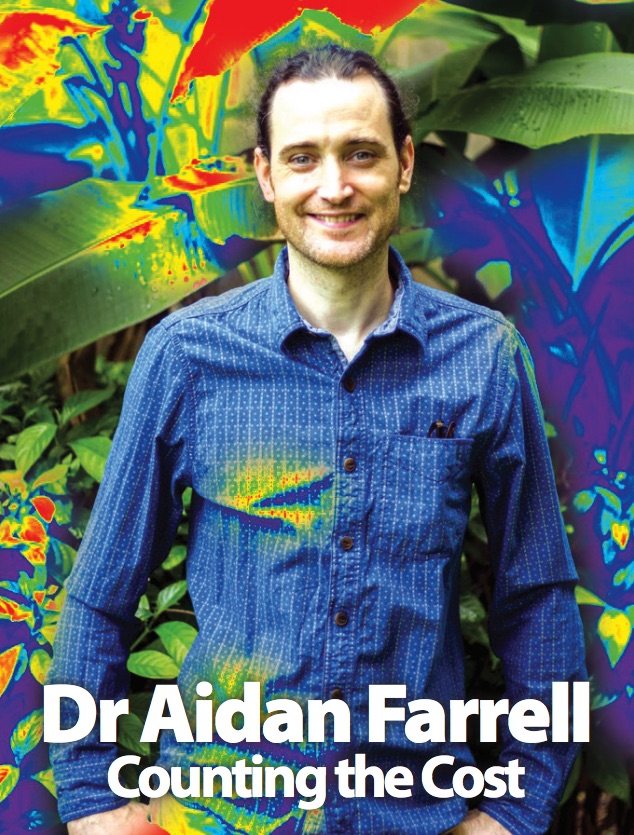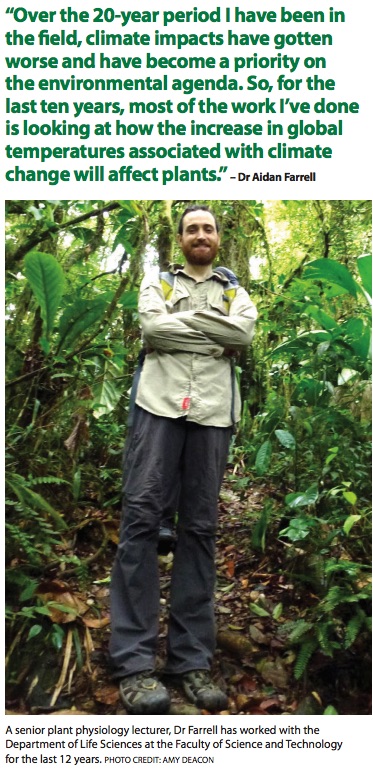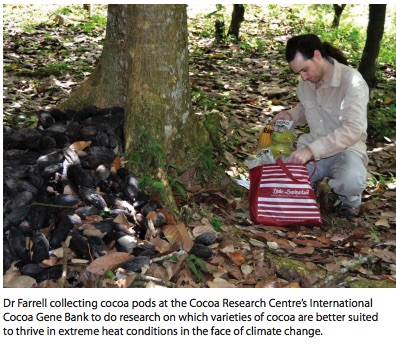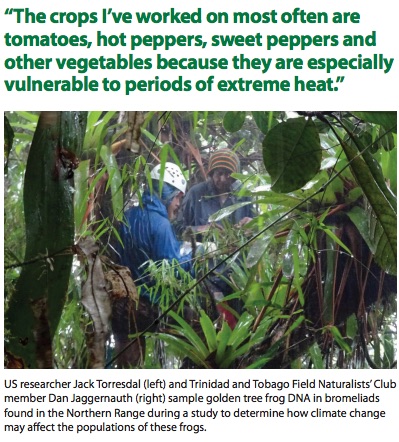 PHOTOS: COURTESY AIDAN FARRELL
PHOTOS: COURTESY AIDAN FARRELL
Focusing on the climate change consequences for local plants, crops, and wildlife
As environmental stakeholders and political representatives from around the world travelled to Egypt in November for the 2022 United Nations Climate Change Conference (COP27), alleviating climate loss and damage was one of the most widely discussed topics.
At the time one writing it seems unlikely that participants at the conference will come up with a singular solution to address the issue, the United Nations Framework Convention on Climate Change (UNFCCC) continues to call on countries to better understand the issue at local levels and make strides towards addressing climate impacts.
At The UWI St Augustine campus, senior plant physiology lecturer Dr Aidan Farrell has been contributing towards local literature by conducting research on the effects of climate change on agriculture and biodiversity over the past several years.
With a PhD in plant physiology, Farrell has worked with the Department of Life Sciences at the Faculty of Science and Technology for the last 12 years.
In an interview with UWI TODAY, he mentioned that his earlier studies – including his PhD research – focused on the general relationship between plants and their environments.
But, given the urgent need for small island developing states like Trinidad and Tobago to understand the effects of climate change, and strengthen their resilience, Farrell felt compelled to do specialised research on the adverse effects of climate change on plants.
Farrell told UWI TODAY, “Over the 20-year period I have been in the field, climate impacts have gotten worse and have become a priority on the environmental agenda. So, for the last ten years, most of the work I’ve done is looking at how the increase in global temperatures associated with climate change will affect plants.”
“We have students looking at different tree species, their distribution around the country, and whether certain trees will be under threat as the climate changes.”

To date, research led by Dr Farrell’s PhD student, Joshua Spiers has found Podocarpus trinitensis – a species of conifer found only in Trinidad – is one of the local tree species most vulnerable to climate change.
Found mostly in cooler places on high mountains, the tree requires delicate environmental conditions to thrive, and changes in temperature and moisture at higher altitudes can affect the survival of the species.
With the delicate relationship between climate and agriculture, Farrell also has a laser focus on researching how tolerant local crops are to harsh climatic conditions.
Growing different varieties of crops in controlled environmental settings – such as different temperatures and light exposure – in greenhouses at The UWI, the aim of Farrell’s research is to determine how tolerant they are to heat and what mechanisms they use to cope.
In doing so, it is possible to determine and suggest more heat-tolerant varieties to farmers in an effort to improve their climate resiliency.
“There is a lot of attention on how we will be able to produce enough food with major changes in climate.“The crops I’ve worked on most often are tomatoes, hot peppers, sweet peppers and other vegetables because they are especially vulnerable to periods of extreme heat.”
While tomato varieties like Hybrid 61 and Heatmaster were found to fare better in heat, they naturally produce less yield when grown under local conditions as opposed to cooler climates, which means climate change can further impact their productivity.

In other studies, Farrell has done research to understand the relationship between climate change and local wildlife. Between 2015 and 2016, Farrell teamed up with US researchers Jack Torresdal and Caren Goldberg who were doing research on the Golden Tree Frog. In the collaborative research, investigations into the effect of climatic conditions on these frogs, which are adapted to cool conditions on Trinidad’s highest mountains, were done.
Spending most of their lives in one species of bromeliad found on the peaks of El Tucuche and El Cerro del Aripo, Farrell said regular research on these frogs has been going on since the 1940s. But in recent years, researchers have struggled to find these frogs in the field, especially without destroying their bromeliad homes.
So, during their research, the team determined the presence of these frogs by looking for their DNA in samples of water taken from bromeliads. This method gave general estimates of their distribution.
With global temperatures already up by at least one degree, Farrell explained some species may have already adapted to this increase by moving to higher altitudes:
“The higher you go in altitude, the temperature usually drops. But, if you have a species that already lives in the top 100 to 150 meters of a mountain peak, it’s not able to move elsewhere.
“The worry is, as temperatures increase, then the environment no longer exists for these frogs to thrive… there is nowhere else for these frogs or bromeliads to move.”

Although this project is complete, Farrell said similar research is currently being done by other researchers, and the topic is ever evolving. Looking forward, he reminds people that local species of flora and fauna already took thousands of years to adapt to local climatic conditions. While scientists hope these ecosystems can develop resilience to climate change, Farrell calls on people to recognise the importance of playing their part in mitigating these changes.
“The ecosystems that exist here took a long time to evolve and the plants and animals changed their physiology to match the kinds of temperatures which naturally occur here.”
“Even when it comes to agriculture, farmers have a particular way and time of sowing crops. But once you get the rapid changes that we are getting where temperatures are increasing faster, all of those systems are put under pressure.”